Aker
-
- The Aker Way: From Surviving to Thriving Maritime Logistics Professional, Q4 2013 #32
Aker’s comeback story isn’t yet over, but the middle chapters certainly make for compelling copy. The nation’s market leader in blue water tankers and containerships looks aft to (painful) lessons learned and at the same time, ahead for additional opportunities.
Aker Philadelphia Shipyard (Oslo: AKPS) is the second-largest commercial shipbuilder in the United States, having built more than one-half of the large ocean-going vessels in the US market since 2003. The key word in all of that is “commercial.” Aker Philadelphia is a Jones Act builder, and was hit hard in the wake of the recent financial crisis. At the nadir of the market crisis, the company was forced to make more than 700 layoffs.
In February 2011, Pennsylvania and Philadelphia taxpayers took a significant gamble, infusing $42 million into the company to build two oceangoing petroleum product tankers on spec. The gamble – Aker prefers to call it ‘market vision’ – paid off handsomely in August 2012 when Aker sold the two ships to Crowley. Since then, it’s been fair winds and following seas for the Philadelphia-based shipyard. Figuring out what comes next requires a look back. How Aker (it rhymes with “soccer”) went from merely surviving to its current condition of thriving is therefore one of the more interesting maritime stories of this year; if not the entire decade.
First time visitors to Aker’s Philadelphia operation immediately notice the massive, modern 660 metric ton, 64 meter (210 feet) tall Goliath crane. Only slightly less impressive is the gleaming infrastructure, reflecting a shipyard that has been completely refurbished and in some places, rebuilt from the ground up. Established first in 1801 – with a rich history with Navy work at its heart – the yard was eventually was closed in 1996. With several starts and stops and hiccups along the way, the location is now, like many other American yards, a thriving beehive of activity. In late November, MarPro traveled to Pennsylvania for a firsthand look at this pure commercial, Jones Act builder.
Market Conditions
A booming shale crude oil industry has created high demand for US-flagged ships for the coastwise transport of oil, gasoline and chemicals. Since the successful sale of the spec ships, Aker Philadelphia has landed contracts for two petroleum tankers for Exxon Mobil affiliate Sea River, as well as a $500 million agreement to build and share in the operation of up to eight additional product tankers for Crowley. And in November, Aker also inked a deal with Matson for two 3600-teu Jones Act containerships – the largest ever to be built in the United States. The contract price was reportedly $418 million for the pair, with deliveries quoted for the 3rd and 4th quarters of 2018.
With four of the Crowley tankers firmly contracted and both parties looking hard at the additional four options, these are heady times for Aker. The shipyard’s solid backlog and strong cash position have pushed its stock price up more than 30 times its market low in mid-2012. Despite the large run-up in market capitalization, the company’s debt load and Total Enterprise Value (TEV) to EBITDA ratio both seem to be reasonable, as compared with its peers. That said; major risks include cancelled contracts and changes to the Jones Act, neither of which seem to be likely in the current political and economic environment.
Steering the Ship
Just 30 years old, Kristian Rokke joined Aker Philadelphia Shipyard in 2007. Prior to that, the Aker CEO held various roles, including SVP Operations and Senior Shop Manager within the shipyard and has experience from offshore service and shipbuilding from several companies in the Aker group. A Board Member of TRG Holding AS, which owns 66.7% of Aker ASA, Rokke is currently completing his MBA at The Wharton School and has also studied economics and mathematics at Colby College, London School of Economics, and Political Science at the Norwegian School of Management (BI).
Joining Rokke is Scott Clapham, SVP Projects and Business Improvements and Jeffrey Theisen, the firm’s Chief Financial Officer. Together, they have helped engineer the shipbuilding giant’s remarkable turnaround, and they have done so in an arguably unconventional style. As a management team, the trio is remarkably closemouthed, but Rokke, in his own quiet, understated manner, summed up some key metrics in the box to the left.
The Aker Way: Lucky or Prescient?
Kristian Rokke eagerly looks ahead to what will come next. He told MarPro in November, “Our order backlog gives us a golden opportunity to strengthen the commercial edge of our shipyard and puts us in good position for whatever comes next.” According to Aker’s CEO, the shipyard’s success in recent years has as much to do with Aker’s attitude as anything else. He insists, “We believed in the product tanker market and put our own money behind that belief.”
Rokke also describes his firm as nimble, creative, and opportunistic. Giving credence to that position, some of the deals put together by Aker in order to survive and indeed thrive, have not been uncomplicated. For example, the recent Matson deal is a straight sale, but others were not.
When Aker built the two product tankers on spec, it was widely considered by most analysts as “a leap of faith.” No one, of course, could know what would come next, and so soon. Or, perhaps the Aker management team did. The public/private move, as a minimum, took courage. The yard had previously built 14 product tankers for OSG and then went from 1,200 employees to roughly 300 in the space of one year. Now looking back from a more comfortable perch, Rokke explains, “We’re proud to be playing an important part in our country’s oil boom, but at the same time, we remain humbled by the events of 2010 and 2011. Today we are seizing opportunities like never before, but we will not forget the lessons taken from those difficult times. We will build off the past, but not be tied to it.”
In a nutshell, Aker had to put into place the public/private partnership in order to build hull numbers 17 & 18. These, in turn, yielded hull numbers 19 and 20 – the SeaRiver hulls. Scott Clapham, SVP Projects and Business Improvements, told MarPro during the same visit, “We aim to keep the equipment and the yard moving and working.” But, unlike others trying to do the same thing elsewhere, Aker had to prove its mettle up front by building the spec hulls. Eschewing a larger short term payoff, the Crowley profit-sharing deal set up the long term benefit of a deeper Crowley relationship and with that, the longer term viability of the shipyard.
Hull numbers 17 and 18 involved profit sharing. And, while Rokke might have a lot of faith in the product tanker market, he certainly couldn’t have known that just as these hulls hit the market that Jones Act freight rates would turn decidedly north, yielding some of the best numbers ever seen in this market. More opportunistic creativity would follow. Next came the joint venture; with 49 percent Aker / 51 percent Crowley ownership (IAW Jones Act compliance), a deal which began to increase cash flow consistent with the steady business. Aker’s CEO added, “We have a history of being creative to maximize opportunities for our stakeholders. The spec vessels are examples of that.”
Rokke explains the big picture even further. “It was by successfully delivering on our commitments to American Shipping/OSG that put us in position to build the spec vessels.” And the spec hulls were important in that Aker chose a proven hull design from Korea, something that would appeal to risk-averse Jones Act potential buyers. Eventually, the spec boats were sold for $90 million each and a profit-sharing arrangement. Rokke adds, “Our long term belief in the market has our shipyard in a position to succeed.”
Today, with Aker riding the meteoric climb in its stock (3,500 percent in comparison with the SP 500 over the same timeframe), Aker’s joint venture with Crowley is just one more reason for Rokke to be optimistic. “We will also contribute significant amounts of capital to the project with Crowley in the driver’s seat. It gives our shareholders direct exposure to the shale boom and we like the risk/reward of the investment. It is a partnership that we are very excited about. Crowley is first-class operator and we build quality ships. That adds value for the end user.”
Best Practices: Here, Abroad and Internally at Aker
“Our goal is to always be better today than we were yesterday.” That’s Kristian Rokke’s stock answer to queries about what Aker is doing better than the rest of the Jones Act shipbuilding market and what Aker – and the rest of the U.S. shipbuilders – need to do to catch up with their foreign counterparts. He added simply, “We focus on delivering on our commitments to the customer.” That entails taking ‘best practices’ from other yards around the world, including Korea. Nevertheless, it was clear that Aker mostly closely aligns itself with a more European model.
Locally, the Aker shipyard has a very European feel to its atmosphere. This extends from the style of furniture in the reconverted office spaces to the distinct Norwegian accents that can sometimes be heard in the hallways. A small percentage of Aker’s approximate 1,200 employees are in fact from Europe. Rokke declined to quantify that number, but it was clear that these involved management visas and the process of taking lessons learned from both European shipyards as well as its own Norwegian parent. And, he added, “We have also learned a great deal from our sister companies, both in the marine and oil and gas sectors.” Aker Solutions, for example, has deep marine roots.
“We have put a high emphasis on harnessing best practices from other shipyards around the world since our start-up. For example, in 2005 we pioneered a partnership with the Korean shipbuilding industry which we continue to refine and develop today.” Aker, he said, emulates some aspects of German automation and parts marking. He added, “We have invested over $400 million in our facilities from the beginning. It starts with an efficient shipyard set up and layout to optimize shipbuilding processes, work flow and material logistics. We melded best practices from many shipyards and ended up with a world class facility that we’re proud of.”
Asked about improvements in efficiency achieved over time involving the economy of scale afforded by repeat, series-build experience, Rokke again declined to be specific, saying only, “We have gone from delivering one ship annually to our present capability of producing three annually in a relatively short time period.” Rokke’s bottom line is simple: come 2018, Aker will be proven across multiple ship classes. At that point, he says, business should take care of itself. That remains to be seen.
At Aker, best practices also extend to giving virtually 90 percent of all shipyard employees off during the holidays (26-31 December), something which Aker says allows them to do necessary equipment maintenance and upgrades. It also makes for a happier shipyard worker. Jeffrey Theisen, the firm’s Chief Financial Officer, told MarPro that Aker had invested as much as $350 million in its workforce, including training. All steel work is done in-house, with multiple plasma cutters and heavy assembly lines. Today, Aker can build vessels up to 116,000 tons DWT and 43 meters beam.
Finally, and with regard to the joint venture and profit sharing hulls, we asked Aker if these close relationships created extra incentives to do a better job and perhaps, a more motivated shipyard employee. Aker executives deny that this is the case, saying that their workforce does the same job on every single hull and regardless of the terms of the deal. And, while it shouldn’t make a difference, it probably does. Especially when people know that the hull they are working on might be leaving the yard, but it won’t leave the bottom line. That’s not a bad thing.
The Rally: Sustainable or Cyclical?
The U.S. Department of Transportation recently said that 15 commercial tankers are on order or under construction at the nation’s shipyards, with half as many additional options are legitimately in play. The biggest commercial shipbuilding boom that the domestic industry has seen in more than three decades is being fueled, in part, by domestic crude shipments that have surpassed 600,000 barrels per day. And, although the so-called Tier II yards – those building smaller but equally important hulls – are also busy, producing wave after wave of OSV’s, inland barges and maritime security hulls of one sort or the other, it is also true that shipbuilding is a cyclical industry.
As U.S. yards enjoy fat backorder books, foreign yards look on enviously as the foreign registered tanker and containership markets continue to exist in an overbuilt, and overcapacity mode. Can the domestic boom last, and if so, for how long? Aker is clearly betting that it will, at least in terms of the Jones Act markets. In the near past, Aker has built 14 product tankers and 4 containerships. Rokke insists, “There are many good shipyards in the U.S., but we are the market leader in those sectors.” And, why not? Where others worry about sequestration and the loss of government dollars, Aker simply concentrates on what it does best. Its current backlog extends to 2018; not including options. Unanswered is what happens then.
Nominally, Aker has so far dispelled the notion that the big U.S. yards can only survive on a steady diet of U.S. government / Navy hulls. And, the federal government has its favorites to build large Navy vessels, destroyers and Coast Guard hulls. Those relationships are unlikely to change and it is also unlikely that nuclear newbuild or refit work could come to Philadelphia. The risks alone to the city and for a Navy that sometimes needs to put vessels out to sea as soon as is possible, seem to preclude that option. Aker will therefore continue down the Jones Act newbuild path; perhaps dipping their toes tentatively into the repair market when (and if) the going gets thin.
It has been a wild ride. Employment at Aker went from about 1,000 in 2010, down to 300 in 2011 and now, back up to almost 1,200 today. In total, the company has won orders for $1.5 billion, and has tripled in size since 2011. As other U.S. yards look to rebalance their portfolios to include a greater percentage of commercial work, Aker already has theirs exactly where they want it.
Separately, U.S. blue water shipbuilding continues to heat up on all fronts. As MarPro went to press, Crowley placed yet another shipbuilding order. Interestingly, and despite the reportedly close relationship with Crowley, Aker didn’t get the recent con-ro order. That award instead went to VT Halter Marine, probably because Crowley apparently wasn’t willing to wait as long as Matson for their deliveries. Certainly, they weren’t about to get in line behind Matson, whose ships won’t arrive until 2018.
Good relationships aside, business is business in the world of marine transportation. Aker’s innovative partnerships and profit sharing deals may well be the wave of the future when it comes to fleet replacement and expansion plans. That’s because while some private operators – like Harvey Gulf, for example – can afford to finance their own newbuild plans on the backs of Moody inspired credit lines, others cannot. Closer ties between builders and operators, each sharing the risks associated with operating U.S. flag tonnage in cabotage trades, will naturally follow. That’s just one way to go from “surviving” to “thriving.” It’s also the Aker Way. – MarPro.
(As published in the 4Q 2013 edition of Maritime Professional - www.maritimeprofessional.com)
-
- Interview: Woodson Ferreira, Aker Solutions, Brazil Marine Technology, Sep 2017 #18
in the world, we have the technology, capacity and capacity of the market. -- Woodson Ferreira – Vice President of Subsea Lifecycle Services in Brazil Aker Solutions is a leading subsea equipment and service provider in Brazil, having participated in pre-salt and post-salt subsea field designs, equipment
-
- The New Name of Finnish Shipbuilding Maritime Reporter, Oct 2004 #32
The announced merger of Kvaerner Masa-Yards and Aker Finyards — both members of the Aker Yards Groups — draws to a conclusion nearly a decade of change within the Finnish shipbuilding community, while providing the technically talented and market capable company with a clear vision for the future.
-
- The Best of Both Worlds Maritime Reporter, May 2003 #26
Oslo-based Aker Kvaerner Yards is irony in action. It serves an ancient industry dominated by older generation, yet is led by a fresh faced young executive. It prospers in a capital and equipment intensive market, yet is helping to re-define some of these relationships via the Internet. The organizat
-
- Aker And Kiewit Form Partnership To Serve Offshore Industry Maritime Reporter, Nov 1991 #143
Aker a.s. and Peter Kiewit Sons, Inc., recently announced their agreement to form Aker Gulf Marine, a Texas partnership. Aker Gulf Marine will offer fabrication and construction services to the offshore oil and gas industry. Aker will own 51 percent and Kiewit 49 percent of the new company. Aker
-
- Interview: Astrid Skarheim Onsum, SVP, Head of Wind, Aker Solutions Maritime Reporter, Apr 2019 #24
wind as an energy source, if current plans come to fruition it could gain ground quickly. Recently we spoke with Astrid Skarheim Onsum, SVP, Head of Wind Aker Solutions, for her view on the path ahead and the growing role and promising future of ‘floating wind.’Please give an overview of your responsibi
-
- AKER FINNYARDS Maritime Reporter, Feb 2000 #50
Based in Rauma, Aker Finnyards recent history is indicative of the changes, which continue to sweep the Finnish maritime scene. Finnyards is owned 100 percent by Norwegian interests, part of Aker Yards, an international shipbuilding group comprising Aker Finnyards together with a German and two Norwegian
-
- Aker Granted $560 Million Contract For Statoil Platform Maritime Reporter, Feb 2002 #21
The Aker Stord subsidiary of the Aker Maritime group has been awarded the main contract for the new platform for Statoil's Kristin development in the Norwegian Sea. Worth approximately $560 million, this assignment covers design and hook-up of the whole installation as well as construction of part of
-
- Kvaerner And Aker Maritime Join Forces Maritime Reporter, Apr 2002 #12
Kvaerner has launched a new company with 18,000 employees in 17 countries and on five continents. The new company, to be known as Aker Kvaerner, will supply products, services, tech- nology and solutions worth $2.2 billion a year to the global oil and gas industry. Aker Kvaerner is the result of a
-
- Hyundai Launches Advanced Aker Semisubmersible Drilling Rig Maritime Reporter, May 1986 #11
An Aker H-4.2 semisubmersible drilling rig, said to be the first of its kind ever constructed, was launched recently from Drydock No. 1 of Hyundai Heavy Industries' (HHI) Ulsan Shipyard in Korea. The advanced unit, worth about $75 million, is built to the Aker H-4.2 design and custom-fitted to
-
- Arctic Energy Exploration Efforts Heat Up Maritime Reporter, Apr 2014 #44
continue to make major commitments to oil and gas exploration operations in the Arctic region,” said Mikko Niini, until recently the managing director at Aker Arctic in Helsinki, and now a senior management advisor. “We’re developing more independent cargo vessel solutions,” said Niini. Some of Aker
-
- Aker Rhymes with “Soccer” Maritime Logistics Professional, Q4 2013 #8
that does not necessarily include a steady diet of government, Coast Guard and/or Navy hulls. Leading the charge to redefine American shipbuilding is Aker Philadelphia Shipyard and its youthful CEO, Kristian Rokke. Riding an enviable backlog of pure commercial, deep draft hulls that stretches all the way
-
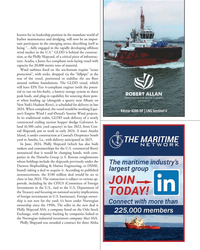 )
August 2024 - Marine News page: 33
)
August 2024 - Marine News page: 33ASA, a company listed on the Oslo Stock 225,000 members Exchange, with majority backing by companies linked to the Norwegian industrial investment company Aker ASA. Philly Shipyard was awarded a contract for three Aloha
-
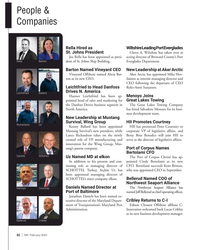 )
February 2024 - Marine News page: 42
)
February 2024 - Marine News page: 42acting director of Broward County’s Port Rella Barton dent of St. Johns Ship Building. Everglades Department. Barton Named Vineyard CEO New Leadership at Aker Arctic Vineyard Offshore named Alicia Bar- Aker Arctic has appointed Mika Hov- ton as its new CEO. ilainen as interim managing director and CEO following
-
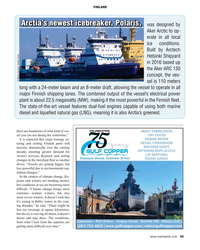 )
November 2023 - Maritime Reporter and Engineering News page: 49
)
November 2023 - Maritime Reporter and Engineering News page: 49FINLAND Arctia’s newest icebreaker, Polaris, was designed by Aker Arctic to op- erate in all local ice conditions. Built by Arctech Helsinki Shipyard in 2016 based up the Aker ARC 130 concept, the ves- © Marko Hannula / Adobe Stock sel is 110 meters long with a 24-meter beam and an 8-meter draft
-
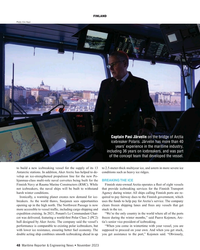 )
November 2023 - Maritime Reporter and Engineering News page: 48
)
November 2023 - Maritime Reporter and Engineering News page: 48FINLAND Photo: Eric Haun Captain Pasi Järvelin on the bridge of Arctia icebreaker Polaris. Järvelin has more than 40 years’ experience in the maritime industry, including 36 years on icebreakers, and was part of the concept team that developed the vessel. to build a new icebreaking vessel for the
-
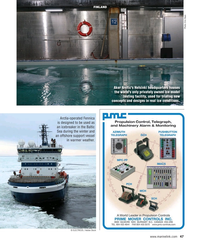 )
November 2023 - Maritime Reporter and Engineering News page: 47
)
November 2023 - Maritime Reporter and Engineering News page: 47FINLAND Photo: Eric Haun Aker Arctic’s Helsinki headquarters houses the world’s only privately owned ice model testing facility, used for trialing new concepts and designs in real ice conditions. Arctia-operated Fennica is designed to be used as an icebreaker in the Baltic Sea during the winter and
-
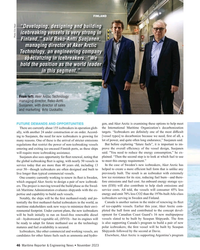 )
November 2023 - Maritime Reporter and Engineering News page: 46
)
November 2023 - Maritime Reporter and Engineering News page: 46“Developing, designing and building icebreaking vessels is very strong in Photo: Eric Haun Finland,” said Reko-Antti Suojanen, managing director at Aker Arctic Technology, an engineering company specializing in icebreakers. “We hold the position as the world leader in this segment.” From left: Aker
-
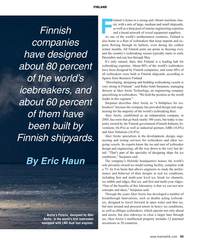 )
November 2023 - Maritime Reporter and Engineering News page: 45
)
November 2023 - Maritime Reporter and Engineering News page: 45F and a broad network of vessel equipment suppliers. Finnish As one of the world’s northernmost countries, Finland is also home to a ? eet of icebreakers that keep imports and ex- companies ports ? owing through its harbors, even during the coldest winter months. All Finnish ports are prone to freezing
-
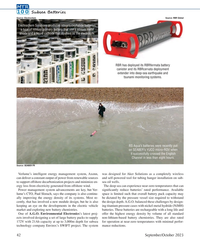 )
September 2023 - Marine Technology Reporter page: 42
)
September 2023 - Marine Technology Reporter page: 42crossed the English Channel in less than eight hours. Source: SEABER FR Verlume’s intelligent energy management system, Axonn, was designed for Aker Solutions as a completely wireless can deliver a constant output of power from renewable sources and self-powered tool for tubing hanger installation
-
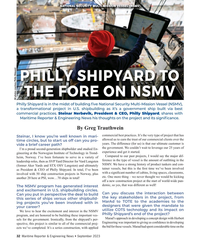 )
September 2023 - Maritime Reporter and Engineering News page: 32
)
September 2023 - Maritime Reporter and Engineering News page: 32in a variety of ference in the type of vessel is the amount of out? tting in the leadership roles, then as SVP Yard Director for Vard Langsten (former Aker Yards and STX OSV Langsten) and ultimately NSMV. We have a strong history of product tankers and con- as President & CEO of Philly Shipyard. In total
-
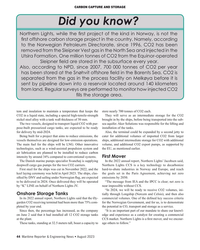 )
August 2023 - Maritime Reporter and Engineering News page: 44
)
August 2023 - Maritime Reporter and Engineering News page: 44thickness of 50 mm. brought in by the ships, before being transported into the sub- The two vessels, designed to transport liquid CO2 with pur- sea aquifer. Aker Solutions was responsible for the lifting and pose-built pressurized cargo tanks, are expected to be ready installation of the tanks. for delivery
-
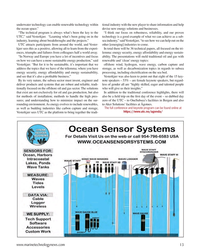 )
May 2023 - Marine Technology Reporter page: 13
)
May 2023 - Marine Technology Reporter page: 13? table business.” Vesterkjær was also keen to point out that eight of the 15 key- By its very nature, the subsea sector must invent, engineer and note speakers – 53% – are female keynote speakers, but regard- deliver products and systems that are robust and reliable, tradi- less of gender all are “highly skilled
-
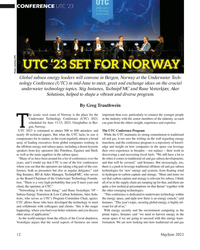 )
May 2023 - Marine Technology Reporter page: 12
)
May 2023 - Marine Technology Reporter page: 12Conference (UTC) in mid-June to meet, greet and exchange ideas on the crucial underwater technology topics. Stig Instanes, TechnipFMC and Rune Vesterkjær, Aker Solutions, helped to shape a vibrant and diverse program. By Greg Trauthwein he scenic west coast of Norway is the place for the important than ever
-
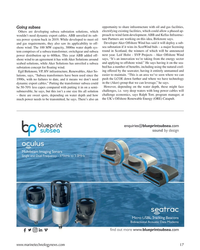 )
January 2022 - Marine Technology Reporter page: 17
)
January 2022 - Marine Technology Reporter page: 17cables. ABB unveiled its sub- sea power system back in 2019. While developed to meet oil ture Partners are working on this idea, Birkmore says. Developer Aker Offshore Wind has said it will deploy a sub- and gas requirements, they also saw its applicability to off- sea substation if it wins its ScotWind bids
-
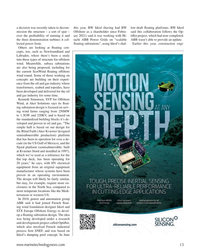 )
January 2022 - Marine Technology Reporter page: 13
)
January 2022 - Marine Technology Reporter page: 13, seabed and topsides, have been developed and delivered for the oil and gas industry for some time. Kenneth Simonsen, SVP for Offshore Wind, at Aker Solutions says its ? oat- ing substation design is focused on serv- ing wind farms ranging from 250MW to 1.3GW and 220KV, and is based on the standardized
-
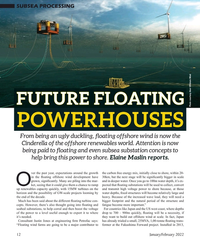 )
January 2022 - Marine Technology Reporter page: 12
)
January 2022 - Marine Technology Reporter page: 12SUBSEA PROCESSING FUTURE FLOATING Photo courtesy Aker Offshore Wind POWERHOUSES From being an ugly duckling, ? oating offshore wind is now the Cinderella of the offshore renewables world. Attention is now being paid to ? oating and even subsea substation concepts to help bring this power to shore.
-
 )
January 2022 - Maritime Reporter and Engineering News page: 48
)
January 2022 - Maritime Reporter and Engineering News page: 48Ship Repair Recent projects and upgrades from ship repair and conversion Kongsberg Maritime Updates Aker BP’s Alvheim FPSO Kongsberg Maritime project team carried out an up- grade of the Safety and Automation Systems on an A Aker BP Floating Production Storage and Of? oading (FPSO). The FPSO was converted
-
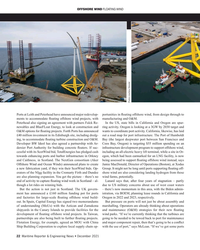 )
December 2021 - Maritime Reporter and Engineering News page: 22
)
December 2021 - Maritime Reporter and Engineering News page: 22ports and harbor infrastructure in Orkney egon, which had been earmarked for an LNG facility, is now and Caithness, in Scotland. The NextGen consortium (Aker being assessed to support ? oating offshore wind instead, says Offshore Wind and Ocean Winds) announced plans to create Jamie MacDonald, Director
-
 )
December 2021 - Maritime Reporter and Engineering News page: 21
)
December 2021 - Maritime Reporter and Engineering News page: 21OFFSHORE WIND FLOATING WIND ing foundations,” says Aker Solutions’ SVP for Offshore helps reduce reliance on what’s currently a very limited mar- Wind, Kenneth Simonsen. “If we’re having something that’s ket for Jones Act-compliant installation vessels, it constrains 80m x 80m, almost like a football ?
-
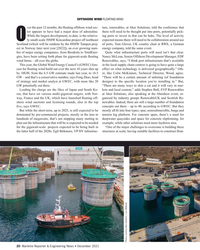 )
December 2021 - Maritime Reporter and Engineering News page: 20
)
December 2021 - Maritime Reporter and Engineering News page: 20OFFSHORE WIND FLOATING WIND ver the past 12 months, the ? oating offshore wind sec- ture, renewables, at Aker Solutions, told the conference that tor appears to have had a major dose of adrenaline. there will need to be thought put into ports, potentially pick- While the largest development, to date
-
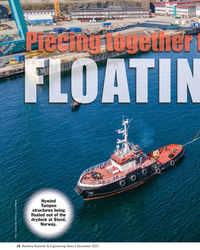 )
December 2021 - Maritime Reporter and Engineering News page: 18
)
December 2021 - Maritime Reporter and Engineering News page: 18OFFSHORE WIND FLOATING WIND Hywind Tampen structures being ? oated out of the d drydock at Stord, , Norway. Photo courtesy Aker Solutions / Lars Melkevik. 18 Maritime Reporter & Engineering News • December 2021 MR #12 (18-33).indd 18 12/2/2021 10:41:49 AM
-
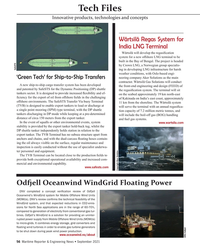 )
September 2021 - Maritime Reporter and Engineering News page: 56
)
September 2021 - Maritime Reporter and Engineering News page: 56Crown LNG, a Norwegian group specialis- ing in developing LNG infrastructure for harsh SafeSTS weather conditions, with Oslo-based engi- neering company Aker Solutions as the main ‘Green Tech’ for Ship-to-Ship Transfers contractor. Wärtsilä Gas Solutions will conduct A new ship-to-ship cargo transfer system
-
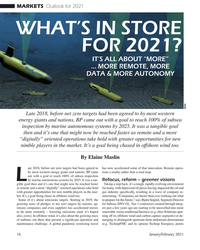 )
January 2021 - Marine Technology Reporter page: 16
)
January 2021 - Marine Technology Reporter page: 16years ago are starting to be unravelled into more to do more remotely – lowering emissions (and, it’s hoped renewable versus traditional business (e.g. Aker Solutions spin- also, costs). In offshore wind, it’s also about the growing mass ning off its offshore wind and carbon capture segments) or de- of
-
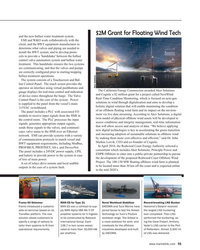 )
May 2020 - Maritime Reporter and Engineering News page: 55
)
May 2020 - Maritime Reporter and Engineering News page: 55to starting/stopping ballast treatment operations. The system consists of a Touchscreen and Bal- last Control Panel. The touch screen provides the Aker Solutions operator an interface using virtual pushbuttons and The California Energy Commission awarded Aker Solutions gauge displays for real-time
-
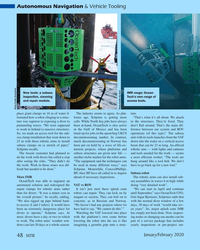 )
January 2020 - Marine Technology Reporter page: 48
)
January 2020 - Marine Technology Reporter page: 48dif- be used in many different ways,” says have to go back up for a new tool.” ? cult but needed to be done.” Schjetne. Meanwhile, ConocoPhillips, BP, Aker BP have all called in to inquire Subsea robot More IMR ahead of necessary inspections. The robotic arms can also install sub- OceanTech was able to
